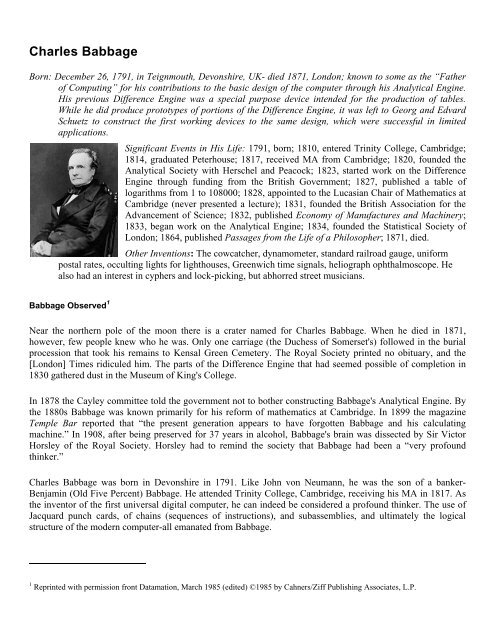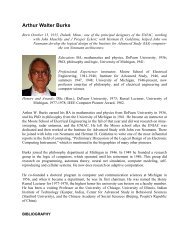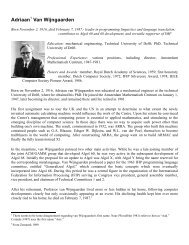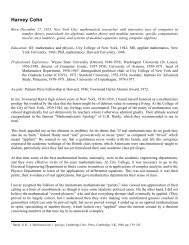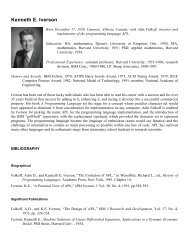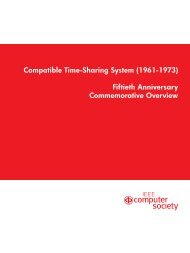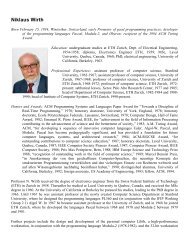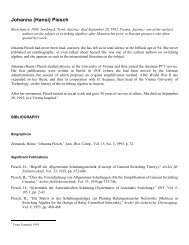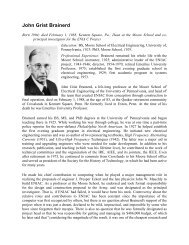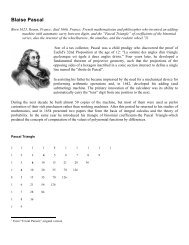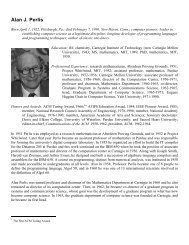Charles Babbage - Walden Family
Charles Babbage - Walden Family
Charles Babbage - Walden Family
Create successful ePaper yourself
Turn your PDF publications into a flip-book with our unique Google optimized e-Paper software.
<strong>Charles</strong> <strong>Babbage</strong><br />
Born: December 26, 1791, in Teignmouth, Devonshire, UK- died 1871, London; known to some as the “Father<br />
of Computing” for his contributions to the basic design of the computer through his Analytical Engine.<br />
His previous Difference Engine was a special purpose device intended for the production of tables.<br />
While he did produce prototypes of portions of the Difference Engine, it was left to Georg and Edvard<br />
Schuetz to construct the first working devices to the same design, which were successful in limited<br />
applications.<br />
Significant Events in His Life: 1791, born; 1810, entered Trinity College, Cambridge;<br />
1814, graduated Peterhouse; 1817, received MA from Cambridge; 1820, founded the<br />
Analytical Society with Herschel and Peacock; 1823, started work on the Difference<br />
Engine through funding from the British Government; 1827, published a table of<br />
logarithms from 1 to 108000; 1828, appointed to the Lucasian Chair of Mathematics at<br />
Cambridge (never presented a lecture); 1831, founded the British Association for the<br />
Advancement of Science; 1832, published Economy of Manufactures and Machinery;<br />
1833, began work on the Analytical Engine; 1834, founded the Statistical Society of<br />
London; 1864, published Passages from the Life of a Philosopher; 1871, died.<br />
Other Inventions: The cowcatcher, dynamometer, standard railroad gauge, uniform<br />
postal rates, occulting lights for lighthouses, Greenwich time signals, heliograph ophthalmoscope. He<br />
also had an interest in cyphers and lock-picking, but abhorred street musicians.<br />
<strong>Babbage</strong> Observed 1<br />
Near the northern pole of the moon there is a crater named for <strong>Charles</strong> <strong>Babbage</strong>. When he died in 1871,<br />
however, few people knew who he was. Only one carriage (the Duchess of Somerset's) followed in the burial<br />
procession that took his remains to Kensal Green Cemetery. The Royal Society printed no obituary, and the<br />
[London] Times ridiculed him. The parts of the Difference Engine that had seemed possible of completion in<br />
1830 gathered dust in the Museum of King's College.<br />
In 1878 the Cayley committee told the government not to bother constructing <strong>Babbage</strong>'s Analytical Engine. By<br />
the 1880s <strong>Babbage</strong> was known primarily for his reform of mathematics at Cambridge. In 1899 the magazine<br />
Temple Bar reported that “the present generation appears to have forgotten <strong>Babbage</strong> and his calculating<br />
machine.” In 1908, after being preserved for 37 years in alcohol, <strong>Babbage</strong>'s brain was dissected by Sir Victor<br />
Horsley of the Royal Society. Horsley had to remind the society that <strong>Babbage</strong> had been a “very profound<br />
thinker.”<br />
<strong>Charles</strong> <strong>Babbage</strong> was born in Devonshire in 1791. Like John von Neumann, he was the son of a banker-<br />
Benjamin (Old Five Percent) <strong>Babbage</strong>. He attended Trinity College, Cambridge, receiving his MA in 1817. As<br />
the inventor of the first universal digital computer, he can indeed be considered a profound thinker. The use of<br />
Jacquard punch cards, of chains (sequences of instructions), and subassemblies, and ultimately the logical<br />
structure of the modern computer-all emanated from <strong>Babbage</strong>.<br />
1 Reprinted with permission front Datamation, March 1985 (edited) ©1985 by Cahners/Ziff Publishing Associates, L.P.
Popularly, <strong>Babbage</strong> is a sort of Abner Doubleday of data processing, a colorful fellow whose portrait hangs in<br />
the anteroom but whose actual import is slight. He is thought about, if at all, as a funny sort of distracted<br />
character with a dirty collar. But <strong>Babbage</strong> was much more than that. He was an amazing intelligence.<br />
The Philosopher<br />
<strong>Babbage</strong> was an aesthete, but not a typical Victorian one. He found beauty in things: stamped buttons, stomach<br />
pumps, railways and tunnels, man's mastery over nature.<br />
A social man, he was obliged to attend the theater. While others dozed at Mozart, <strong>Babbage</strong> grew restless.<br />
“Somewhat fatigued with the opera [Don Juan],” he writes in the autobiographical Passages From the, Life of a<br />
Philosopher, “I went behind the scenes to look at the mechanism.” There, a workman offered to show him<br />
around. Deserted when his Cicerone answered a cue, he met two actors dressed as “devils with long forked<br />
tails.” The devils were to convey Juan, via trapdoor and stage elevator, to hell.<br />
In his box at the German Opera some time later (again not watching the stage), <strong>Babbage</strong> noticed “in the cloister<br />
scene at midnight” that his companion's white bonnet had a pink tint. He thought about “producing colored<br />
lights for theatrical representation.” In order to have something on which to shine his experimental lights,<br />
<strong>Babbage</strong> devised “Alethes and Iris,” a ballet in which sixty damsels in white were to dance. In the final scene, a<br />
series of dioramas were to represent Alethes' travels. One diorama would show animals “whose remains are<br />
contained in each successive layer of the earth. In the lower portions, symptoms of increasing heat show<br />
themselves until the centre is reached, which contains a liquid transparent sea, consisting of some fluid at white<br />
heat, which, however, is filled up with little infinitesimal eels, all of one sort, wriggling eternally.”<br />
Two fire engines stood ready for the “experiment of the dance,” as <strong>Babbage</strong> termed the rehearsal. Dancers<br />
“danced and attitudinized” while he shone colored lights on them. But the theater manager feared fire, and the<br />
ballet was never publicly staged.<br />
<strong>Babbage</strong> enjoyed fire. He once was baked in an oven at 265' for “five or six minutes without any great<br />
discomfort,” and on another occasion was lowered into Mt. Vesuvius to view molten lava. Did he ponder hell?<br />
He had considered becoming a cleric, but this was not an unusual choice for the affluent graduate with little<br />
interest in business or law. In 1837 he published his Ninth Bridgewater Treatise, to reconcile his scientific<br />
beliefs with Christian dogma. <strong>Babbage</strong> argued that miracles were not, as Hume wrote, violations of laws of<br />
nature, but could exist in a mechanistic world. As <strong>Babbage</strong> could program long series on his calculating<br />
machines, God could program similar irregularities in nature.<br />
<strong>Babbage</strong> investigated biblical miracles. “In the course of his analysis,” wrote B.V. Bowden in Faster than<br />
Thought (Pitman, London, 1971), “he made the assumption that the chance of a man rising from the dead is one<br />
in 10 12 .” Miracles are not, as he wrote in Passages From the Life of a Philosopher, “the breach of established<br />
laws, but ... indicate the existence of far higher laws.”<br />
The Politician<br />
Of all his roles, <strong>Babbage</strong> was least successful at this one. He had himself to blame: he was too impatient, too<br />
severe with criticism, too crotchety. Bowden wrote that in later life <strong>Babbage</strong> “was frequently and almost<br />
notoriously incoherent when he spoke in public.” What ultimately kept him from building an Analytical Engine
was not his inability to finish a project, but his inadequacies as a political man, as a persuader. His vision was<br />
not matched by his judgment, patience, or sympathy.<br />
<strong>Babbage</strong> was a confusing political figure. A liberal republican, he was pro-aristocratic and strongly antisocialist.<br />
Friend to <strong>Charles</strong> Dickens and to the workman, he was a crony to the Midlands industrialist. The son of a Tory<br />
banker, he supported the cooperative movement and was twice an unsuccessful Whig candidate to Parliament.<br />
But his liberalism waned during the 1840s; by 1865, he was a conservative utilitarian for whom capitalism and<br />
democracy were incompatible.<br />
In July 1822, <strong>Babbage</strong> wrote a letter to the president of the Royal Society, describing his plan for calculating<br />
and printing mathematical tables by machine. By June 1823 <strong>Babbage</strong> met with the Chancellor of the Exchequer,<br />
who granted money and told <strong>Babbage</strong> to proceed with the engine (which he did, starting work in July). But no<br />
minutes were made of this initial meeting.<br />
In August 1827, <strong>Babbage</strong>'s 35 year-old wife, Georgiana, died. <strong>Babbage</strong> traveled to the Continent. By the end of<br />
1828 he returned to England, the initial £1,500 grant gone. <strong>Babbage</strong> was financing the construction himself.<br />
And the exchequer could not recall promising further funds.<br />
Convincing the government to continue with two tons of brass, hand-fitted steel, and pewter clockwork was not<br />
easy. In 1829 a group of <strong>Babbage</strong>'s friends solicited the attention of the Duke of Wellington, and then the Prime<br />
Minister. Wellington went to see a model of the engine and in December ordered a grant of £3,000. Engineer<br />
Joseph Clement 1 was hired to construct the engine for the government, and to oversee the fabrication of special<br />
tools. By the end of 1830 <strong>Babbage</strong> wanted to move the engine's workshop to his house on Dorset Street. A<br />
fireproof shop was built where <strong>Babbage</strong>'s stables had stood. A man of great ego, Clement refused to move from<br />
his own workshop, and made, according to <strong>Babbage</strong>, “inordinately extravagant demands.” <strong>Babbage</strong> would not<br />
advance Clement further money, so Clement dismissed his crew, and work on the Difference Engine ceased.<br />
This did not seem to perturb <strong>Babbage</strong>. His initial scheme for the Difference Engine called for six decimal places<br />
and a second-order difference; now he began planning for 20 decimal places and a sixth-order difference. “His<br />
ambition to build immediately the largest Difference Engine that could ever be needed,” wrote Bowden,<br />
“probably delayed the exploitation of his own ideas for a century.”<br />
With Clement and his tools gone, <strong>Babbage</strong> wanted to meet with Prime Minister Lord Melbourne in 1834 to tell<br />
him of a new machine he had conceived-the Analytical Engine, an improved device capable of any<br />
mathematical operation. He contended it would cost more to finish the original engine than to construct this new<br />
one. But the government did not wish to fund a new engine until the old one was complete. “He was ill judged<br />
enough,” wrote the Reverend Richard Sheepshanks, a secretary of the Royal Astronomical Society, “to press the<br />
consideration of this new machine upon the members of Government, who were already sick of the old one.”<br />
(Sheepshanks was <strong>Babbage</strong>'s archenemy. In 1854 he published a vituperative 100-page work, “Letter to the<br />
Board of Visitors of the Greenwich Royal Observatory, in Reply to the Calumnies of Mr. <strong>Babbage</strong>,” at its<br />
meeting in June 1853, and in his book entitled The Exposition of 1851.)<br />
1 See separate biography of Joseph Clement.
For the next eight years <strong>Babbage</strong> continued to apply to the government for a decision on whether to continue<br />
the suspended Difference Engine or begin the Analytical Engine, seemingly unaware of the social problems that<br />
preoccupied Britain's leaders during what Macauley called the Hungry Forties. Although £17,000 of public<br />
money had been spent, and a similar amount by <strong>Babbage</strong>, the Prime Minister avoided him. “It is nonsense,”<br />
wrote Sheepshanks, “to talk of consulting a Prime Minister about the kind of Calculating Machine that he<br />
wants.” Prime Minister Robert Peel recommended that <strong>Babbage</strong>'s machine be set to calculate the time at which<br />
it would be of use. “ I would like a little previous consideration,” wrote Peel, “before I move in a thin house of<br />
country gentlemen a large vote for the creation of a wooden man to calculate tables from the formula x2+x+41.”<br />
Finally, in November 1842, the Chancellor of the Exchequer, having sought the opinion of Sir George Airy on<br />
the utility of the machine, and having been told it was “worthless,” said he and Peel regretted the necessity of<br />
abandoning the project. On November 11, <strong>Babbage</strong> finally met with Peel and was told the bad news.<br />
By 1851 <strong>Babbage</strong> had “given up all expectation of constructing the Analytic Engine,” even though he was to try<br />
once more with Disraeli the next year. He wrote in the vitriolic Exposition of 1851: “Thus bad names are coined<br />
by worse men to destroy honest people, as the madness of innocent dogs arises from the cry of insanity raised<br />
by their villainous pursuers.”<br />
Some believed <strong>Babbage</strong> had “been rewarded for his time and labor by grants from the public use,” according to<br />
biographer Moseley Maboth (Irascible Genius). “We got nothing for our £17,000 but Mr. <strong>Babbage</strong>'s<br />
grumblings,” wrote Sheepshanks in his “Letter to the Board of Visitors of the Greenwich Royal Observatory.”<br />
“We should at least have had a clever toy for our money.”<br />
Peel, however, declared in Parliament that <strong>Babbage</strong> “had derived no emolument whatsoever from the<br />
government.” Offered a baronetcy in recognition of his work, <strong>Babbage</strong> refused, demanding a life peerage<br />
instead. It was never granted.<br />
The Music Hater<br />
Lady Lovelace wrote that <strong>Babbage</strong> hated music. He tolerated its more exquisite forms, but abhorred it as<br />
practiced on the street. “Those whose minds are entirely unoccupied,” he wrote with some seriousness in<br />
Observations of Street Nuisances in 1864, “receive [street music] with satisfaction, as filling up the vacuum of<br />
time.” He calculated that 25% of his working power had been destroyed by street nuisances, many of them<br />
intentional. Letters to the Times and the eventual enforcement of “<strong>Babbage</strong>'s Act,” which would squelch street<br />
nuisances, made him the target of ridicule.<br />
The public tormented him with an unending parade of fiddlers, Punch-and Judys, stilt-walkers, fanatic<br />
psalmists, and tub-thumpers. Some neighbors hired musicians to play outside his windows. Others willfully<br />
annoyed him with worn-out or damaged wind instruments. Placards were hung in local shops, abusing him.<br />
During one 80-day period <strong>Babbage</strong> counted 165 nuisances. One brass band played for five hours, with only a<br />
brief intermission. Another blew a penny tin whistle out his window toward <strong>Babbage</strong>'s garden for a half hour<br />
daily, for “many months.”<br />
When <strong>Babbage</strong> went out, children followed and cursed him. Adults followed, too, but at a distance. Over a<br />
hundred people once skulked behind him before he could find a constable to disperse them. Dead cats and other<br />
“offensive materials” were thrown at his house. Windows were broken. A man told him, “You deserve to have
your house burnt up, and yourself in it, and I will do it for you, you old villain.” Even when he was on his<br />
deathbed, the organ-grinders ground away implacably.<br />
In <strong>Babbage</strong>'s relation with “the Mob,” we see his curious naïveté in matters social. Although he was far above<br />
the rabble-”not unknown” to the Duke of Wellington and Lord Ashley-he seemed unaware of it at times. He<br />
expected the same civility from a drunken brothel-keeper as he would from a gentleman. In 1860, the London of<br />
the multitudinous poor was far from gentle. Yet, in his ingenuousness, he could fathom neither bums nor<br />
bamboozlers. He would cross town to check the tale of a mendicant, and frequently was surprised to encounter<br />
deceit.<br />
<strong>Babbage</strong> once met a man who claimed not to have eaten for two days. <strong>Babbage</strong> invited him to breakfast. The<br />
next morning he called at <strong>Babbage</strong>'s house, claiming hard times. Eventually, the man hired on as a steward on a<br />
small West Indian ship. “A few evenings after the ship had supposed to have sailed, he called at my house,”<br />
wrote <strong>Babbage</strong>, “apparently much agitated and stated that, in raising the anchor, an accident had happened, by<br />
which the captain's leg had been broken.” <strong>Babbage</strong> later tried to verify this tale, but found his steward “had been<br />
living riotously at some public-house in another quarter, and had been continually drunk.”<br />
<strong>Babbage</strong> never understood that the growth and crowdedness of London resulted from the industrial expansion<br />
he championed. By 1850 industry had taken over in Britain. “Many years before, I had purchased a house in a<br />
very quiet locality,” he wrote in 1864. Then came a hackney stand, and beer shops and coffeehouses, and<br />
people. The din beneath his window, the German bands, the pickpockets, came with industry. The railroad and<br />
factory brought crowds to London, and with them came meanness and thievery.<br />
The Newtonian<br />
Like Newton, <strong>Babbage</strong> was Lucasian professor of mathematics at Cambridge. He founded both the British<br />
Association's Statistical Society and the Royal Astronomical Society. His Difference Engine calculated by<br />
Newton's method of successive differences, and would even accomplish “operations of human intellect” by<br />
motive power. <strong>Babbage</strong> believed in a world where, once all things were dutifully quantified, all things could be<br />
predicted. As such, he was a perfect Newtonian.<br />
Nature, according to Question 31 of Newton's Opticks, is “very consonant and conformable to herself.”<br />
Newton's program was official in <strong>Babbage</strong>'s time. Science “consisted in isolating some central, specific act, and<br />
then using it as the basis for all further deductions concerning a given set of phenomena,” writes Ilya Prigogine<br />
in Order Out of Chaos. The Marquis Laplace, an avid Newtonian and friend of <strong>Babbage</strong>, said that if a mind<br />
could know everything about particle behavior, it could describe everything: “Nothing would be uncertain, and<br />
the future, as the past, could be present to our eyes.”<br />
<strong>Babbage</strong> wanted to quantify everything. Fact and data intoxicated him. He tried handicapping horse races<br />
mathematically. <strong>Babbage</strong>'s love of numbers was well known: in the mail he received requests for statistics. He<br />
would preserve any fact, simply because he thought “the preservation of any fact might ultimately be useful.”<br />
He would stop to measure the heartbeat of a pig (to be listed in his “Table of Constants of the Class<br />
Mammalia”), or to affix a numerical value to the breath of a calf. In 1856 he proposed to the Smithsonian<br />
Institution that an effort be made to produce “Tables of Constants of Nature and Art,” which would “contain all<br />
those facts which can be expressed by numbers in the various sciences and arts.”
<strong>Babbage</strong> delighted in the thought of having a daily account of food consumed by zoo animals, or the<br />
“proportion of sexes amongst our poultry.” He proposed tables to calibrate the amount of wood (elm or oak) a<br />
man would saw in ten hours, or how much an ox or camel could plow or mow in a day.<br />
<strong>Babbage</strong>'s unflagging fascination with statistics occasionally overwhelmed him, as is seen in the animation of<br />
his Smithsonian proposal. “If I should be successful,” he wrote, “. . . it will thus call into action a permanent<br />
cause of advancement toward truth, continually leading to the more accurate determination of established fact,<br />
and to the discovery and measurement of new ones.”<br />
In Mechanics Magazine in 1857 <strong>Babbage</strong> published a “Table of the Relative Frequency of the Causes of<br />
Breaking of Plate Glass Windows,” detailing 464 breakages, of which “drunken men, women, or boys” were<br />
responsible for fourteen. <strong>Babbage</strong> thought the table would be “of value in many respects,” and might “induce<br />
others to furnish more extensive collections of similar and related facts.”<br />
<strong>Babbage</strong> faced significant problems with mechanical techniques. He had to invent the tools for his engine. His<br />
thought is so thoroughly modern that we wonder why he did not pursue electromechanical methods for his<br />
engines (especially after Faraday's 1831 discovery of induction and <strong>Babbage</strong>'s own electrical experiments). It is<br />
easy to forget how long ago <strong>Babbage</strong> worked.<br />
Even under the best of circumstances, the limitations of Newtonian physics might have prevented <strong>Babbage</strong> from<br />
completing any Analytical Engine. He did not know the advances of Maxwell (and could not know those of<br />
Boltmann, Gödel, and Heisenberg). Although he knew Fourier socially, <strong>Babbage</strong> did not seem to grasp the<br />
importance of his 1811 work on heat propagation, nor did he seem to know of Joule's efforts with heat and<br />
mechanical energy.<br />
The reversibility of attraction is a basic tenet of Newtonian mechanics. A body, or piece of information, may<br />
retrace its path and return to where it started. In <strong>Babbage</strong>'s design for the Analytical Engine, the discrete<br />
functions of mill (in which “all operations are performed”) and store (in which all numbers are originally<br />
placed, and, once computed, are returned) rely on this supposition of reversibility.<br />
In his 1824 essay on heat, Carnot formulated the first quantitative expression of irreversibility, by showing that<br />
a heat engine cannot convert all supplied heat energy into mechanical energy. Part of it is converted to useful<br />
work, but most is expelled into a low-temperature reservoir and wasted.<br />
From this observation came William Thomson's discovery of the Second Law of Thermodynamics in 1852, and<br />
Rudolf Clausius' discovery of entropy in 1865. In ideal reversible processes, entropy remains constant. But in<br />
others, as Eddington showed with his “arrow of time,” entropy only increases; thus, information cannot be<br />
shuttled between mill and store without leaking (some possibility of error), like faulty sacks of flour. <strong>Babbage</strong><br />
did not consider this problem, and it was perhaps his greatest obstacle to building the engine.<br />
It is easy to forget that <strong>Babbage</strong> was essentially a child of the Enlightenment, and that his epoch was much<br />
different from our own. He resided in an era of wood and coal, and the later era of steel and oil would not begin<br />
for perhaps a decade after his death.<br />
The Industrialist
“Faith in machinery,” wrote Matthew Arnold in Culture and Anarchy in 1869, “is our besetting danger.” The<br />
Whiggery of the mid-Victorian era optimistically endorsed the principle of progress. Britain changed from the<br />
relatively pastoral society of 1820 to the brutishly materialistic one of the 1840s and 1850s.<br />
<strong>Babbage</strong> shared his era's enthusiasm for industry. His finest work, On the Economy of Manufactures, was<br />
published in 1832. In it, with watch in hand, <strong>Babbage</strong> discovers operational research, the scientific study of<br />
manufacturing processes. It is a tour of the manufacturing processes of the period, from needle-making to<br />
tanning. <strong>Babbage</strong> detailed how things both ornamental and functional were made in mid-nineteenth century<br />
Britain. His characteristically blunt analysis of the printing trade caused publishers to refuse his books.<br />
<strong>Babbage</strong> worked when industry was in a frenzy to improve and expand. Increases in manufacturing and<br />
population were viewed as “absolute goods in themselves,” noted Matthew Arnold. In Das Kapital, Marx<br />
quoted from Economy of Manufactures on this rage to improve: “Improvements succeeded each other so<br />
rapidly, that machines which had never been finished were abandoned in the hands of their makers, because<br />
new improvements had superseded their utility.”<br />
<strong>Babbage</strong> disliked Plato, according to his friend Wilmot Buxton, because of Plato's condemnation of Archytas,<br />
“who had constructed machines of extraordinary power on mathematical principles.” Plato thought such an<br />
application of geometry degraded a noble intellectual exercise, “reducing it to the low level of a craft fit only for<br />
mechanics and artisans.”<br />
<strong>Babbage</strong> loved practical science, and was among the first to apply higher mathematics to certain commercial<br />
and industrial problems. He took no part in what Anthony Hyman (in his book, <strong>Charles</strong> <strong>Babbage</strong>) called the<br />
era's “growing divorce between academic science and engineering practice.”<br />
<strong>Babbage</strong> had a forge built in his house on Devonshire Street, and accomplished, with his draftsmen, pioneering<br />
work in precision engineering. Because conventional mechanical drawing proved inadequate for his engines, he<br />
had to develop his own abstract notation. He called his work with mechanical notation “one of the most<br />
important additions I have made to human knowledge.”<br />
With the die-cast pewter gear wheels of his Difference Engine, and with his design of lathes and tool-shapers,<br />
<strong>Babbage</strong> did much to advance the British machine tool industry. Joseph Whitworth (later Sir), foreman in<br />
<strong>Babbage</strong>'s shop, was responsible for the introduction of the first series of standard screw threads.<br />
The expansion of the railways marked the grandest phase of the industrial revolution. Railroads freed<br />
manufacturing from its dependence on water transport, and opened new markets. When the first public railroad,<br />
the Stockton & Darlington, opened on September 27, 1823, <strong>Babbage</strong> was 34. By 1841 there were over 1,300<br />
miles of rail in Britain, and 13,500 miles by 1870. J.D. Bernal wrote in Science and Industry in the Nineteenth<br />
Century, that “<strong>Babbage</strong> seems to have been one of the few who interested themselves scientifically in its [the<br />
railroad's] working.” <strong>Babbage</strong>'s life was intertwined with the railroad. He invented a cow catcher in 1838,<br />
apparently the first in Britain. He was present for opening ceremonies of George Stephenson's Manchester &<br />
Liverpool line in 1830. Of the cheering crowds at the initial run, he wrote, “I feared . . . the people madly<br />
attempting to stop by their feeble arms the momentum of our enormous train.”<br />
<strong>Babbage</strong>'s great formal association with railroads came in 1837 and 1838, when he conducted experiments for<br />
I.K. Brunel's Great Western Railway, which ran from London to Bristol. <strong>Babbage</strong> argued for the superiority of
Brunel's wide-gauge track. His research into the safety and efficiency of the line was, according to Bernal, “100<br />
years ahead of his time.”<br />
<strong>Babbage</strong> rode the rails like a river pilot road the Mississippi, knowing every turn on the route, every crossing,<br />
every intersection. “My ear,” he wrote, “had become peculiarly sensitive to the distant sound of an engine.”<br />
The Misanthrope<br />
<strong>Babbage</strong> was known as a “mathematical Timon.” In his later years he came to suffer from a mechanist's<br />
misanthropy, regarding men as fools and grubby thieves. By 1861 he said he had never spent a happy day in his<br />
life, and would gladly give up the rest of it if he could live three days 500 years thence.<br />
Laughed at by costermongers and viscounts, met with diffidence by his lessers, the impatient <strong>Babbage</strong> grew<br />
angry, like the cave-dwelling Timon, with a changing world. Nevertheless, as his friend Lionel Tollemache<br />
wrote, “there was something harmless and even kindly in his misanthropy, for ... he hated mankind rather than<br />
man, and his aversion was lost in its own generality.”<br />
Like Shakespeare's Timon, <strong>Babbage</strong> would have made a fascinating leader. (Sheepshanks, of course, disagreed:<br />
“I don't know any Government office or any other office for which he is fit, certainly none which requires sense<br />
and good temper.”)<br />
What a delightful, if distracting, place it would be where <strong>Babbage</strong> was in charge. Consider his plan in Economy<br />
of Manufactures for a “simple contrivance of tin tubes for speaking through.” (<strong>Babbage</strong> calculated it would take<br />
17 minutes for words spoken in London to reach Liverpool.) Or his plan for sending messages “enclosed in<br />
small cylinders,” along wires suspended from high pillars (he thought church steeples could be used for this<br />
purpose.)<br />
In Passages, <strong>Babbage</strong> relates how, as a youth, he nearly drowned while testing his contrivance for walking on<br />
water. In Conjectures on the Conditions of the Surface of the Moon, we find him describing his 1837<br />
experiments in cooking a “very respectable stew of meat and vegetables” in blackened boxes (with window<br />
glass) buried in the earth. Toward the end of his life we find him mulling the prevention of bank note forgery<br />
and working in marine navigation. We realize that, with his harlequin curiosity about all things, and with his<br />
wonderfully human sense of wonder, <strong>Babbage</strong> escapes pathos and attains greatness.<br />
QUOTATIONS<br />
“Some of my critics have amused their readers with the wildness of the schemes I have occasionally thrown out;<br />
and I myself have sometimes smiled along with them. Perhaps it were wiser for present reputation to offer<br />
nothing but profoundly meditated plans, but I do not think knowledge will be most advanced by that course;<br />
such sparks may kindle the energies of other minds more favorably circumstanced for pursuing the enquiries.”<br />
(On the Economy of Machinery and Manufactures, 1832, preface to second edition)<br />
“Every moment dies a man/Every moment 1 1 / 16 is born.' (A correction to Tennyson's “Every moment a man<br />
dies/Every moment one is born.”)
“If unwarned by my example, any man shall undertake and shall succeed in really constructing an engine ...<br />
upon difference principles or by simpler means, I have no fear of leaving my reputation in his charge, for he<br />
alone will be fully able to appreciate the nature of my efforts and the value of their results.” 1<br />
BIBLIOGRAPHY<br />
Biographical<br />
<strong>Babbage</strong>, Henry P., ed., <strong>Babbage</strong>'s Calculating Engines: Being a Collection of Papers Relating to Them, Their<br />
History, and Construction, E. and F.N. Spoon, London, 1889.<br />
<strong>Babbage</strong>, H.P., “<strong>Babbage</strong>'s Analytical Engine,” reprinted in Randell, Brian, ed., Origins of Digital Computers:<br />
Selected Papers, Springer-Verlag, Berlin Heidelberg, 1982, pp. 19-54.<br />
<strong>Babbage</strong>, Neville F., “Autopsy Report on the Body of <strong>Charles</strong> <strong>Babbage</strong> (“the father of the computer”),” Medical<br />
J. Australia, Vol. 154, 1991, pp. 758-759.<br />
Bromley, Alan G., “<strong>Charles</strong> <strong>Babbage</strong>'s Analytical Engine,” Ann. Hist. Comp., Vol. 4, No. 3, 1982, p. 196.<br />
Buxton, W.H., Memoir of the Life and Labours of the Late <strong>Charles</strong> <strong>Babbage</strong> E'sq. FR.S., Vol. 13, <strong>Charles</strong><br />
<strong>Babbage</strong> Institute Reprint Series of the History of Computing, MIT Press, Cambridge, Mass., 1988.<br />
Campbell-Kelly, Martin, “<strong>Charles</strong> <strong>Babbage</strong>'s Table of Logarithms,” Ann. Hist. Comp., Vol. 10, No. 3, 1988, p.<br />
159ff.<br />
Campbell-Kelly, Martin, ed., The Works of <strong>Charles</strong> <strong>Babbage</strong>, Pickering and Chatto, London, 1989, 11<br />
Volumes.<br />
Cohen, L Bernard, “<strong>Babbage</strong> and Aiken,” Ann. Hist. Comp., Vol. 10, No. 3, 1988, p. 171ff.<br />
Davies, Donald Watts, “<strong>Babbage</strong>'s Friend,” (CQD), Ann. Hist. Comp., Vol. 12, No. 2, 1990, p. 147ff.<br />
Dubbey, J. M., The Mathematical Work of <strong>Charles</strong> <strong>Babbage</strong>, Cambridge Univ. Press, New York, 1978.<br />
Froehlich, Leopold, “<strong>Babbage</strong> Observed,” Datamation, Cahners/Ziff Pub. Assoc., Mar. 1985.<br />
Gridgeman, N. T., The Mathematical Work of <strong>Charles</strong> <strong>Babbage</strong> (review), Ann. Hist. Comp., Vol. 1, No. 1,<br />
1979.<br />
Halacy, Dan, <strong>Charles</strong> <strong>Babbage</strong>, Father of the Computer, Macmillan, New York, 1970.<br />
Harrison, Thomas J., “<strong>Charles</strong> and the Computer,” Measurement and Control, Vol. 19, Apr. 1986, pp. 84-91.<br />
Hyman, Anthony, <strong>Charles</strong> <strong>Babbage</strong>, Pioneer of the Computer, Princeton Univ. Press, Princeton, N.J.,1982.<br />
Hyman, Anthony, “<strong>Babbage</strong> Studies,” (CQD), Ann. Hist. Comp., Vol. 11, No. 3, 1989, p. 225ff.<br />
Huskey, Harry and Velma, “Lady Lovelace and <strong>Charles</strong> <strong>Babbage</strong>,” Ann. Hist. Comp., Vol. 2, No. 4, 1980, pp.<br />
299-329.<br />
Huskey, Harry and Velma, “<strong>Charles</strong> <strong>Babbage</strong> and Lady Lovelace,” (anecdote), Ann. Hist. Comp., Vol. 3, No. 4,<br />
198 1, p. 414ff.<br />
1<br />
Quoted in the <strong>Babbage</strong> exhibit at the Science Museum, Kensington; attributed to <strong>Babbage</strong> in 1864.
Huskey, Velma, “Who Was the Mysterious Countess?,” (anecdote), Ann. Hist. Comp., Vol. 7, No. 1, 1985, p.<br />
58ff.<br />
Kean, David W., The Author of the Analytical Engine, Thompson Book Co., Washington D.C., 1966.<br />
Morrison, Philip and Emily, <strong>Charles</strong> <strong>Babbage</strong> and his Calculating Machines, Dover Publications, New York,<br />
1961.<br />
Nagler, Harry, “Napier and <strong>Babbage</strong>,” (anecdote), Ann. Hist. Comp., Vol. 2, No. 2, 1980, p. 186ff.<br />
Robert, C.J.D., “<strong>Babbage</strong>'s Diff. Eng. No.1 and ... Sine Tables,” (CQD), Ann. Hist. Comp., Vol. 9, No. 2, 1987,<br />
p. 210ff.<br />
Slater, Robert, Portraits in Silicon, MIT Press, Cambridge, Mass., 1987.<br />
Smillie, K. W., “Mr. <strong>Babbage</strong>'s Calculating Machine,” (CQD), Ann. Hist. Comp., Vol. 2, No. 3, 1980, p. 268ff.<br />
van Sinderen, Alfred, “The Printed Papers of <strong>Charles</strong> <strong>Babbage</strong>,” Ann. Hist. Comp., Vol. 2, No. 2,1980, pp. 169-<br />
185.<br />
van Sinderen, Alfred, “The Trinity House,” (correction), Ann. Hist. Comp., Vol. 3, No. 1, 1981, p. 73.<br />
van Sinderen, Alfred, “A. Hyman: <strong>Charles</strong> <strong>Babbage</strong>” (review), Ann. Hist. Comp., Vol. 5, No. 1, 1983, p. 76.<br />
van Sinderen, Alfred, “<strong>Babbage</strong>'s Letter to Quetelet, May 1835,” Ann. Hist. Comp., Vol. 5 No. 3, 1983, p.<br />
263ff.<br />
van Sinderen, Alfred, “<strong>Babbage</strong> and the Scheutz Machine Ann. Hist. Comp., Vol. 10, No. 2, 1988, p. 133ff.<br />
van Sinderen, Alfred, “<strong>Babbage</strong> and Bowditch,” (CQD), Ann. Hist. Comp., Vol. 10, No. 3, 1988, p. 218ff.<br />
Wilkes, Maurice V., “<strong>Babbage</strong>, <strong>Charles</strong>” in Ralston, Anthony, and Edwin D. Reilly Jr., Encyclopedia of<br />
Computer Science and Engineering, Van Nostrand Reinhold Co., New York, 1983 1 .<br />
Wilkes, Maurice V., “<strong>Babbage</strong>'s Expectations for the Diff. Engine,” (anecdote), Ann. Hist. Comp., Vol. 9, No.<br />
2, 1987, p. 203ff.<br />
Wilkes, Maurice V., “<strong>Babbage</strong> and the Colossus,” (CQD), Ann. Hist. Comp., Vol. 10, No. 3, 1988, p. 218ff.<br />
Wilkes, Maurice V., “<strong>Babbage</strong>'s Expectations for his Engines,” Ann. Hist. Comp., Vol. 13, No. 2, 199 1, pp.<br />
141-146.<br />
Wilkes, Maurice V., “Pray, Mr. <strong>Babbage</strong>…,” A Play, Ann. Hist. Comp., Vol. 13, No. 2,1991, pp. 147-154.<br />
Wilkes, Maurice V., “<strong>Charles</strong> <strong>Babbage</strong>-The Great Uncle of Computing?,” Comm. ACM, Vol. 35, No. 3, 1992,<br />
pp. 15-16,21.<br />
Significant Publications<br />
<strong>Babbage</strong>, <strong>Charles</strong>, “Observations on the Application of Machinery to the Computation of Mathematical<br />
Tables,” Memoirs of the Astronomical Society, Vol. 1, No. 2, 1825, pp. 311-314.<br />
<strong>Babbage</strong>, <strong>Charles</strong>, Economy of Machinery and Manufactures, <strong>Charles</strong> Knight, London, 1832.<br />
1<br />
Also in 3ed edition.
<strong>Babbage</strong>, <strong>Charles</strong>, “On the Mathematical Powers of the Calculating Engine, unpublished MS, reprinted in<br />
Randell, B., ed., The Origins of Digital Computers: Selected Papers, Springer-Verlag, Berlin, 1973, pp.<br />
19-54.<br />
<strong>Babbage</strong>, <strong>Charles</strong>, Passages from the Life of a Philosopher, Longmans and Green, London, 1864, reprinted with<br />
introduction by Martin Campbell-Kelly, IEEE Press, Piscataway, NJ., 1994.<br />
UPDATES<br />
(<strong>Babbage</strong> portrait inserted by MRW, 2012)


